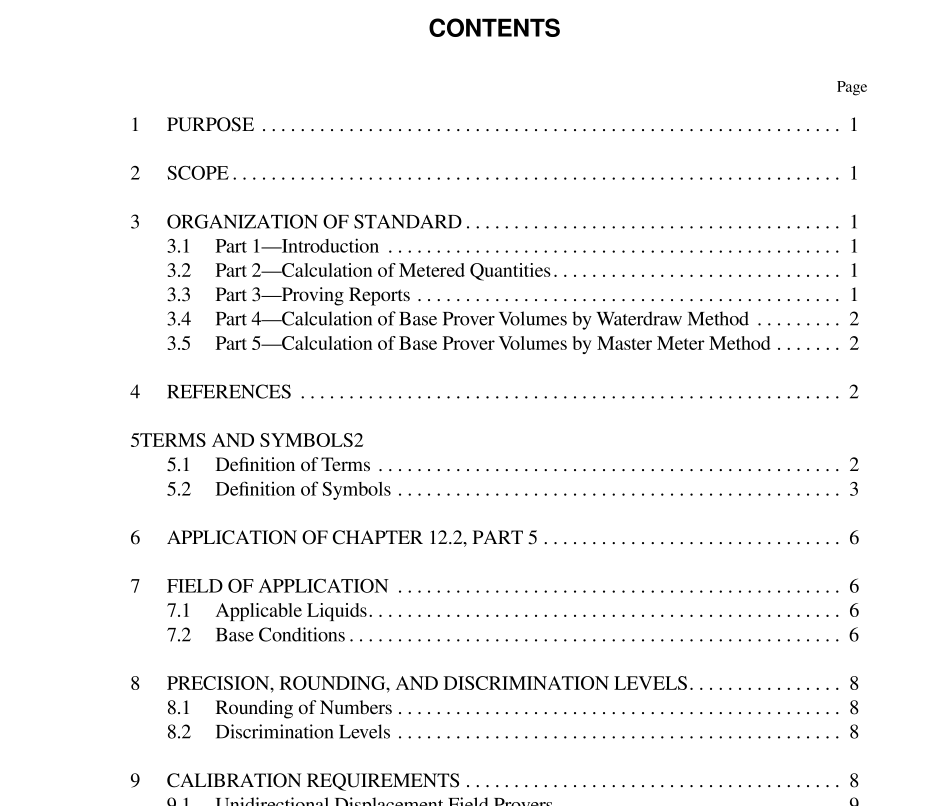API MPMS 12.2.5 pdf download

API MPMS 12.2.5 pdf download.Section 2—Calculation of Petroleum Quantities Using Dynamic Measurement Methods and Volumetric Correction Factors
1 Purpose
1.1 When most of the older standards were written, mechanical desk calculators were widely used for calculating measurement documentation, and tabulated values were used more widely than is the case today. Rules for rounding and the choice of how many figures to enter in each calculation step were often made on the spot. As a result, different opera- tors obtained different results from the same data. 1.2 This multi-part publication consolidates and standard- izes calculations pertaining to metering petroleum liquids using turbine or displacement meters and clarifies terms and expressions by eliminating local variations of such terms. The purpose of standardizing calculations is to produce the same unbiased answer from the given data. For different operators to obtain identical results from the same data, the rules for sequence, rounding and discrimination of figures (or decimal places) must be defined.
2 Scope
2.1 This part provides standardized calculation methods for the quantification of liquids and the determination of base prover volumes under defined conditions, regardless of the point of origin or destination or units of measure required by governmental customs or statute. The criteria contained in this document allows different entities using various com- puter languages on different computer hardware (or manual calculations) to arrive at identical results using the same stan- dardized input data. 2.2 This document also specifies the equations for comput- ing correction factors, rules for rounding, including the calcu- lational sequence, and discrimination levels to be employed in the calculations. No deviations from these specified equa- tions are permitted, since the intent of this document is to establish a rigorous standard.
3 Organization of Standard
This standard is organized into five separate parts. Part 1 contains a complete general introduction to dynamic mea- surement calculations. Part 2 focuses on the calculation of metered quantities for measurement tickets. Part 3 applies to the calculation of meter factors in proving operations and proving reports. Part 4 applies to the determination of base prover volumes by the water draw method, and Part 5 explains the calculation steps required to determine base prover volume by the master meter method. 3.1 PART 1—INTRODUCTION 3.1.1 The base (reference or standard) volumetric determi- nation of metered quantities is discussed, along with the gen- eral terms required for solution of equations. 3.1.2 General rules for rounding of numbers, including field data and intermediate calculational numbers and dis- crimination levels, are specified. 3.1.3 For the proper use of this standard, prediction of the density of the liquid in both flowing and base conditions is discussed. 3.1.4 An explanation of the principal correction factors associated with dynamic measurement is presented. 3.2 PART 2—CALCULATION OF METERED QUANTITIES 3.2.1 The application of this standard to the calculation of metered quantities is presented, for base volumetric cal- culations in conformance with North American industry practices. 3.2.2 Recording of field data, rules for rounding, discrimi- nation levels, calculational sequences, along with a detailed explanation of the calculation steps, are all specified, together with appropriate flow charts and a set of example calculations. These examples can be used as an aid in check- ing out the procedures for any computer calculation routines that are developed on the basis of the requirements stated in this standard.3.4 PART 4—CALCULATION OF BASE PROVER VOLUMES BY WATERDRAW METHOD 3.4.1 The waterdraw method uses the displacement (or drawing) of water from the prover into certified volumetric field standard test measures. Alternatively, for open tank provers, the waterdraw method may also use the displace- ment (or drawing) of water from field standard test measures into the open tank prover. Certification of the field standard measures must be traceable to an appropriate national weights and measures organization. 3.4.2 Recording of field data, rules for rounding, calcula- tion sequence and discrimination levels are specified, along with a set of example calculations. The examples are designed to aid in checkout procedures for any routines that are developed using the requirements stated in this part.









